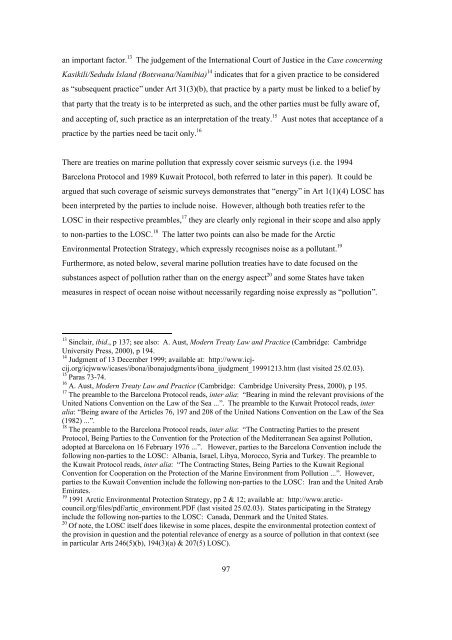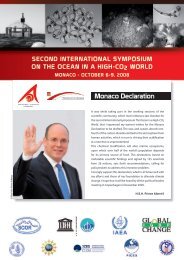an important factor. 13 The judgement <strong>of</strong> the International Court <strong>of</strong> Justice in the Case concerningKasikili/Sedudu Isl<strong>and</strong> (Botswana/Namibia) 14 indicates that for a given practice to be consideredas “subsequent practice” under Art 31(3)(b), that practice by a party must be linked to a belief bythat party that the treaty is to be interpreted as such, <strong>and</strong> the other parties must be fully aware <strong>of</strong>,<strong>and</strong> accepting <strong>of</strong>, such practice as an interpretation <strong>of</strong> the treaty. 15 Aust notes that acceptance <strong>of</strong> apractice by the parties need be tacit only. 16There are treaties on marine pollution that expressly cover seismic surveys (i.e. the 1994Barcelona Protocol <strong>and</strong> 1989 Kuwait Protocol, both referred to later in this paper). It could beargued that such coverage <strong>of</strong> seismic surveys demonstrates that “energy” in Art 1(1)(4) LOSC hasbeen interpreted by the parties to include <strong>noise</strong>. However, although both treaties refer to theLOSC in their respective preambles, 17 they are clearly only regional in their scope <strong>and</strong> also applyto non-parties to the LOSC. 18 The latter two points can also be made for the ArcticEnvironmental Protection Strategy, which expressly recognises <strong>noise</strong> as a pollutant. 19Furthermore, as noted below, several marine pollution treaties have to date focused on thesubstances aspect <strong>of</strong> pollution rather than on the energy aspect 20 <strong>and</strong> some States have takenmeasures in respect <strong>of</strong> ocean <strong>noise</strong> without necessarily regarding <strong>noise</strong> expressly as “pollution”.13 Sinclair, ibid., p 137; see also: A. Aust, Modern Treaty Law <strong>and</strong> Practice (Cambridge: CambridgeUniversity Press, 2000), p 194.14 Judgment <strong>of</strong> 13 December 1999; available at: http://www.icjcij.org/icjwww/icases/ibona/ibonajudgments/ibona_ijudgment_19991213.htm(last visited 25.02.03).15 Paras 73-74.16 A. Aust, Modern Treaty Law <strong>and</strong> Practice (Cambridge: Cambridge University Press, 2000), p 195.17 The preamble to the Barcelona Protocol reads, inter alia: “Bearing in mind the relevant provisions <strong>of</strong> theUnited Nations Convention on the Law <strong>of</strong> the Sea ...”. The preamble to the Kuwait Protocol reads, interalia: “Being aware <strong>of</strong> the Articles 76, 197 <strong>and</strong> 208 <strong>of</strong> the United Nations Convention on the Law <strong>of</strong> the Sea(1982) ...”.18 The preamble to the Barcelona Protocol reads, inter alia: “The Contracting Parties to the presentProtocol, Being Parties to the Convention for the Protection <strong>of</strong> the Mediterranean Sea against Pollution,adopted at Barcelona on 16 February 1976 ...”. However, parties to the Barcelona Convention include thefollowing non-parties to the LOSC: Albania, Israel, Libya, Morocco, Syria <strong>and</strong> Turkey. The preamble tothe Kuwait Protocol reads, inter alia: “The Contracting States, Being Parties to the Kuwait RegionalConvention for Cooperation on the Protection <strong>of</strong> the Marine Environment from Pollution ...”. However,parties to the Kuwait Convention include the following non-parties to the LOSC: Iran <strong>and</strong> the United ArabEmirates.19 1991 Arctic Environmental Protection Strategy, pp 2 & 12; available at: http://www.arcticcouncil.org/files/pdf/artic_environment.PDF(last visited 25.02.03). States participating in the Strategyinclude the following non-parties to the LOSC: Canada, Denmark <strong>and</strong> the United States.20 Of note, the LOSC itself does likewise in some places, despite the environmental protection context <strong>of</strong>the provision in question <strong>and</strong> the potential relevance <strong>of</strong> energy as a source <strong>of</strong> pollution in that context (seein particular Arts 246(5)(b), 194(3)(a) & 207(5) LOSC).97
This evidence therefore suggests that the “subsequent practice” to date does not establishagreement <strong>of</strong> the parties to the LOSC regarding the interpretation <strong>of</strong> the term “energy” in Art1(1)(4) LOSC. However, Brownlie states that “[s]ubsequent practice by individual parties alsohas some probative value” 21 <strong>and</strong> Sinclair considers that subsequent practice which does notqualify under Art 31(3)(b) “may nonetheless constitute a supplementary means <strong>of</strong> interpretationwithin the meaning <strong>of</strong> Article 32 <strong>of</strong> the [Vienna] Convention”. 22 It should also be borne in mindthat awareness <strong>of</strong> the environmental impact <strong>of</strong> ocean <strong>noise</strong> <strong>and</strong> the regulatory response to such<strong>noise</strong> are still very much emerging issues. As the issue matures, State practice will becomeincreasingly valuable as a guide to interpretation <strong>of</strong> the term “energy” within the definition <strong>of</strong>pollution in Art 1(1)(4) LOSC.Art 32 (“Supplementary means <strong>of</strong> interpretation”) <strong>of</strong> the Vienna Convention allows recourse to,inter alia, the preparatory work <strong>of</strong> the treaty as a supplementary means <strong>of</strong> interpretation (a) toconfirm the meaning resulting from the application <strong>of</strong> Art 31 or (b) to determine the meaningwhen the interpretation according to Art 31 leaves the meaning ambiguous or obscure or leads toa result which is manifestly absurd or unreasonable. The definition <strong>of</strong> “pollution <strong>of</strong> the marineenvironment” in Art 1(1)(4) LOSC approximates to definitions adopted initially by the Group <strong>of</strong>Experts on the Scientific Aspects <strong>of</strong> the Marine Environment (“GESAMP”) <strong>and</strong> latterly by the1972 United Nations Conference on the Human Environment. 23 Dotinga <strong>and</strong> Oude Elferinkstate: 24Initially, the definition <strong>of</strong> marine pollution discussed in GESAMP only referred to theintroduction <strong>of</strong> substances. At a later stage the term “energy” was added, apparently toinclude thermal pollution, since there was evidence available to show that heat in seawaterencouraged the development <strong>of</strong> certain undesirable organisms <strong>and</strong> interfered with themigration <strong>of</strong> fish in certain areas.Thus it is possible that those drafting Art 1(1)(4) LOSC had thermal pollution (rather than <strong>noise</strong>)specifically in mind when they used the term “energy”. However, any evidence along these lines21 I. Brownlie, Principles <strong>of</strong> Public International Law, 5 th edition (Oxford: Clarendon Press, 1998), p 635.22 I. Sinclair, The Vienna Convention on the Law <strong>of</strong> Treaties, 2 nd edition, Mell<strong>and</strong> Schill Monographs inInternational Law (Manchester: Manchester University Press, 1984), p 138.23 S.N. N<strong>and</strong>an, S. Rosenne & N.R. Gr<strong>and</strong>y (eds.), United Nations Convention on the Law <strong>of</strong> the Sea 1982:A Commentary vol II (Dordrecht: Martinus Nijh<strong>of</strong>f), p 41.24 H.M. Dotinga & A.G. Oude Elferink, Acoustic Pollution in the <strong>Oceans</strong>: The Search for Legal St<strong>and</strong>ards,Ocean Development & International Law, 31: 151-182, 2000, p 158.98
- Page 2:
Oceans of Noise 2004A WDCS Science
- Page 8 and 9:
In the US, the deployment of Low Fr
- Page 10 and 11:
its propagation beyond those declar
- Page 12 and 13:
The best evidence for noise being f
- Page 14 and 15:
Box 1. Characteristics of sound / l
- Page 16 and 17:
Sound speed (c)The speed (c) of a w
- Page 18 and 19:
Box 2. The effects of temperature,
- Page 20 and 21:
2.1.2. Measuring sound intensityIde
- Page 22 and 23:
i.e. Equal pressure measurements di
- Page 24 and 25:
Spherical or Geometrical spreading
- Page 28 and 29:
5.0 145Tug pulling loaded barge 1.0
- Page 30 and 31:
The source used during 3-D surveys
- Page 32 and 33:
Machinery noisePropulsion machinery
- Page 34 and 35:
Man-made islands /caissonsFixed pla
- Page 36 and 37:
12 3245Drill bit6Figure 3.4. Sound
- Page 38 and 39:
Transientnoise sourcesAircraftHelic
- Page 40 and 41:
Results from the aerial surveys con
- Page 42 and 43:
haemorrhaging in the inner ears and
- Page 44 and 45:
However they also noted that whales
- Page 46 and 47:
4. The Use of Sound by CetaceansChr
- Page 48 and 49: seems logical, therefore, that if t
- Page 50 and 51: However, despite the reported low a
- Page 52 and 53: Kamminga and Wiersma 1981;Akamatsu
- Page 54 and 55: SongSocial callsShrieksSlaps0.03-80
- Page 56 and 57: anthropogenic factors that make the
- Page 58 and 59: 5.3 Longer-term impactsNoise is cle
- Page 60 and 61: 5.4 Indirect impactsThe above impac
- Page 62 and 63: decompression sickness (DCS) as see
- Page 64 and 65: 6. Examples of regional and nationa
- Page 66 and 67: 6.3 ASCOBANS and ACCOBAMSTwo region
- Page 68 and 69: implications and the discussion sho
- Page 70 and 71: 7.1. Consideration of Voluntary vs.
- Page 72 and 73: acoustic measurements have been mad
- Page 74 and 75: 7.6. Methods of protectionComplianc
- Page 76 and 77: 7.6.1 Monitoring7.6.1.1 Visual, aco
- Page 78 and 79: Delory et al. (2002) use Ambient No
- Page 80 and 81: 8. ReferencesAburto, A., Rountry, D
- Page 82 and 83: Caldwell, M.C., Caldwell, D.K., and
- Page 84 and 85: Engas, A., Lokkeborg, S., Ona, E. a
- Page 86 and 87: IWC 2002b. Report of the Scientific
- Page 88 and 89: McCauley, R.D. 1994. Seismic Survey
- Page 90 and 91: Potter, J. and Delory, E. 2001. Noi
- Page 92 and 93: Smolker, R.A., Mann, J. and Smuts,
- Page 94 and 95: Watkins, W.A. 1981b. The activities
- Page 96 and 97: ANNEX 1The Application of Marine Po
- Page 100 and 101: in the preparatory work of the LOSC
- Page 102 and 103: practice by the UNEP Governing Coun
- Page 104 and 105: protection and preservation of the
- Page 106 and 107: than international rules, standards
- Page 108 and 109: Four of the twelve regional seas tr
- Page 110 and 111: seismic operations in the Protocol
- Page 112 and 113: ConclusionAt the global level, only
- Page 114 and 115: Art 209 LOSC focuses on both standa
- Page 116 and 117: No State Party may impose condition
- Page 118 and 119: coastal States”. This formulation
- Page 120 and 121: If the IMO makes this determination
- Page 122 and 123: estrictions to vessels operating in
- Page 124 and 125: In the EEZ, in comparison to the te
- Page 126 and 127: Appendix A - Some international ins
- Page 128 and 129: Convention for the Protection of th
- Page 130 and 131: Available at:http://www.unep.ch/sea
- Page 132 and 133: BucharestConventionArticle XIPollut
- Page 134 and 135: environment1. The Contracting Parti
- Page 136 and 137: - that under Article III.8.c) of AC
- Page 138 and 139: e) no sudden or repeated change in
- Page 140 and 141: Ref: Nowacek et al. 2001.Location:
- Page 142 and 143: Location: Arctic• Vocal behaviour
- Page 144 and 145: • Vaquita surfacing duration and
- Page 146 and 147: • 6% of small delphinids (n=264;
- Page 148 and 149:
Species type: Boto, Inia geoffrensi
- Page 150 and 151:
• Humpback whales appeared tolera
- Page 152 and 153:
• Behaviour interpreted as aggres
- Page 154 and 155:
• There was no evidence of minke
- Page 156 and 157:
• Northern right whales may be ap
- Page 158 and 159:
• Migrating gray whales disturbed
- Page 160 and 161:
to Ensenada De La Paz, Mexico. Aqua
- Page 162 and 163:
distribution of humpback whales, Me
- Page 164 and 165:
Richardson, C.R. Greene, C.I. Malme
- Page 166 and 167:
Zhou, K., Pilleri, G. and Li, Y. 19
- Page 168 and 169:
6. surveys for Cuvier’s beaked wh




